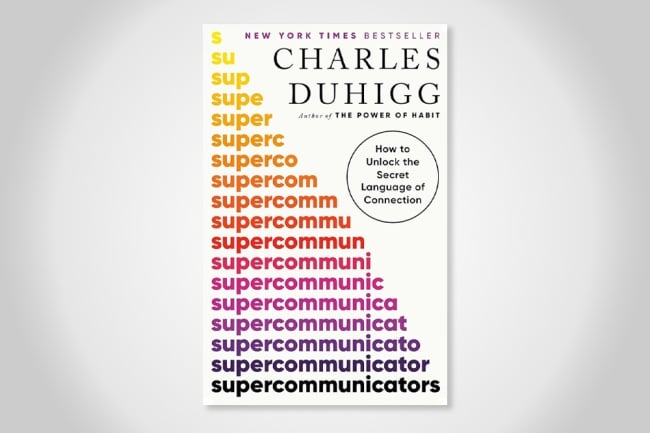You have /5 articles left.
Sign up for a free account or log in.

Penguin Random House
Supercommunicators: How to Unlock the Secret Language of Connection by Charles Duhigg
Published in February 2024
A request that I sometimes get is to recommend a book for this or that higher ed gathering. Sometimes, folks are looking for a book that a unit/division/team can read in preparation for a meeting, such as a strategic planning retreat. At other times, the goal is to find a book that can create opportunities for conversation for colleagues coming together from different universities.
For the past month or so, the book I’ve been recommending to my higher ed colleagues as perfect for small teams and big gatherings alike is Charles Duhigg’s Supercommunicators.
Why recommend a book to our higher ed community when the book has nothing to do with higher ed?
Before answering that question, let me ask you one: How are things going at work?
Specifically, how are you and your colleagues navigating our new world of hybrid academic work?
One theme of Supercommunicators is that digitally mediated communication is super hard. Well, all communication is difficult. But remove the nonverbal cues that we all rely on to understand and make ourselves understood, and even the best intentioned of us will fail to connect.
Duhigg, a New Yorker writer and author of The Power of Habit (2012, my review) and Smarter Faster Better (2016, my review), set out to write Supercommunicators to learn how he could communicate better at work.
The book starts by observing that some people seem to be natural supercommunicators. These rare individuals are the ones that everyone wants on their work teams and units. These colleagues seem to be able to connect with a wide variety of personalities and with coworkers with diverse experiences, worldviews and styles.
You may know a supercommunicator at your university.
Duhigg found, through a broad survey of social science and psychological research on effective communication, that supercommunicator skills can be learned. Those colleagues who come across as natural supercommunicators have likely been actively working on their skills for many years. Supercommunicators are more made than born.
Higher education professional work is communication intensive and almost always team-based. If your primary job at a university is not teaching or research and you work on a computer, then much of what constitutes the job is communicating.
Where in pre-pandemic times, our professional university workplace communications were a mix of face-to-face and digital interactions, today, the balance has firmly swung to the digital.
How many emails and Slack messages do you read and send a day? How much time is spent on Zoom meetings? Even our face-to-face meetings usually include some zooming in of participants.
In the digital world of post-pandemic academic work, we must learn to be supercommunicators. Here, Supercommunicators (the book) is helpful, as Duhigg offers practical and actionable advice.
The big idea from Supercommunicators that has most stuck with me is to try to remember to think about what everyone in a conversation (especially a digital one) wants from the exchange. After reading the book, I find myself constantly thinking about what sort of conversation this person wants to have. What are their goals for this discussion?
While it may be annoying to my colleagues (annoying them is something I often do after reading a new book and trying to apply its lessons), I now start many discussions (usually on Zoom) by asking, “So what sort of conversation are you hoping to have?”
As supercommunicators are good at sharing their feelings and vulnerabilities, I’ll let my Zoom meeting companions know what conversation I hope to have. (I’ll also tell them about the book Supercommunicators and why it has been so influential in my thinking.)
My other significant learning from Supercommunicators is that every conversation occurs on two levels. There is the thing that people are talking about (the work, the project, the deadline, etc.) and the underlying emotional content of every interaction. Supercommunicators (the people) are very good at tuning in to other people’s emotions and then authentically matching the pitch of those feelings in a discussion.
The challenge is that email and Zoom are poor mechanisms for conveying and understanding emotions. Irony and gentle teasing do not translate well to the digital world. It is hard to understand why a colleague says what they do from an email message or a Zoom video feed.
Today’s hybrid academic workplace is an improvement in many important ways. None of us would want to give up the flexibility and autonomy that comes from being able to work and collaborate wherever we are. Many of us work with amazing colleagues who do not come to campus daily. We wouldn’t want to go back. Reading Supercommunicators has persuaded me, however, that universities need to do a far better job at pairing flexible work with more support, attention and focus on communication.
Higher education professional work is today more flexible and, I’d argue, more productive. However, it is also less enjoyable. Satisfaction comes from the quality of our relationships, and relationships are hard to create, build, maintain and evolve when most communication is through email and Zoom.
We need to figure out how to build deep and trusting relationships with colleagues, primarily through digital communication tools. Our higher education professional staff workforce must endeavor to become digital supercommunicators.
Reading Supercommunicators would be an excellent place to start.
What are you reading?








